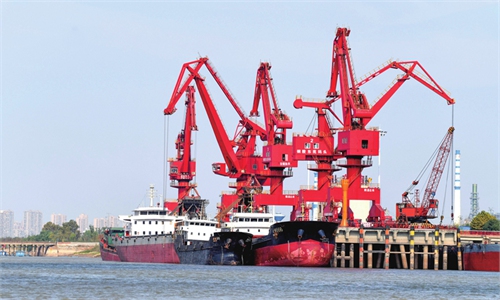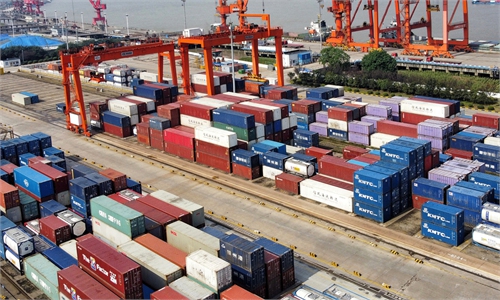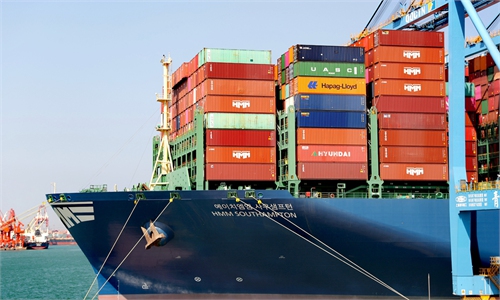
People walk near Lake Burley Griffin in Canberra, Australia, Oct. 30, 2021.Photo:Xinhua
The growth rate of China's imports from Australia declined for the first time in 2021, though demand from both sides remain solid despite souring bilateral ties, according to data released by the General Administration of Customs (GAC) on Sunday.
Analysts say that declining iron ore imports and prices may be the major reason behind the slower growth in China-Australia bilateral trade.
From January to October, China's imports from Australia grew 43.6 percent year-on-year, down nearly two percentage points from the growth rate in the first nine months, according to the GAC.
Meanwhile, China imported a total of 91.61 million tons of iron ore and its concentrates in October, down 4.01 million tons from the previous month, a decline of year-on-year 14.2 percent.
"The price and volume of iron ore imported from Australia have been declining recently, which may have a significant impact on the overall bilateral trade since iron ore plays an indispensable role in the trade," Wang Guoqing, research director at the Beijing Lange Steel Information Research Center, told the Global Times on Sunday.
Wang noted that the Australian economy may have also been affected as the result of the decline in iron ore exports to China, as the Australian economy largely relies on its exports of the commodity.
Moreover, Wang said that China's steel industry is being upgraded and transforming its structure in a bid to achieve the carbon neutral goal, while the country has been working on preserving more iron ore resources and diversifying both domestic and global mine resources, which will help reduce China's reliance on iron ore from Australia.
Analysts stressed that trade demand in both sides is still large especially as the two countries are recovering economically from the COVID-19 pandemic.
"China remains Australia's largest trade partner and has imported a variety of products from Australia, so both countries have a strong trade complementarity," Song Wei, a research fellow at the Chinese Academy of International Trade and Economic Cooperation, told the Global Times on Sunday.
The total trade between the two countries reached $18.98 billion, with China's exports to Australia accounting $6.42 billion and China's imports from Australia reaching $12.56 billion.
Song, who visited the ongoing 4th China International Import Expo (CIIE) held in Shanghai, noted that Australia enterprises appear to be active at the exhibition even though tense bilateral ties have affected the bilateral trade on a certain level.
According to Song, among all Australian products displayed at the CIIE, agricultural products and cosmetic products have been quite popular with relatively large-sized displays, showing that Australian enterprise are still highly interested and attracted to the Chinese market with its strong purchasing power. More than 80 Australian firms are attending this year's CIIE
Song also pointed out that the bilateral trade relations for the long run will still be impacted by the political relations between the two countries.
Global Times

People walk near Lake Burley Griffin in Canberra, Australia, Oct. 30, 2021.Photo:Xinhua
The growth rate of China's imports from Australia declined for the first time in 2021, though demand from both sides remain solid despite souring bilateral ties, according to data released by the General Administration of Customs (GAC) on Sunday.
Analysts say that declining iron ore imports and prices may be the major reason behind the slower growth in China-Australia bilateral trade.
From January to October, China's imports from Australia grew 43.6 percent year-on-year, down nearly two percentage points from the growth rate in the first nine months, according to the GAC.
Meanwhile, China imported a total of 91.61 million tons of iron ore and its concentrates in October, down 4.01 million tons from the previous month, a decline of year-on-year 14.2 percent.
"The price and volume of iron ore imported from Australia have been declining recently, which may have a significant impact on the overall bilateral trade since iron ore plays an indispensable role in the trade," Wang Guoqing, research director at the Beijing Lange Steel Information Research Center, told the Global Times on Sunday.
Wang noted that the Australian economy may have also been affected as the result of the decline in iron ore exports to China, as the Australian economy largely relies on its exports of the commodity.
Moreover, Wang said that China's steel industry is being upgraded and transforming its structure in a bid to achieve the carbon neutral goal, while the country has been working on preserving more iron ore resources and diversifying both domestic and global mine resources, which will help reduce China's reliance on iron ore from Australia.
Analysts stressed that trade demand in both sides is still large especially as the two countries are recovering economically from the COVID-19 pandemic.
"China remains Australia's largest trade partner and has imported a variety of products from Australia, so both countries have a strong trade complementarity," Song Wei, a research fellow at the Chinese Academy of International Trade and Economic Cooperation, told the Global Times on Sunday.
The total trade between the two countries reached $18.98 billion, with China's exports to Australia accounting $6.42 billion and China's imports from Australia reaching $12.56 billion.
Song, who visited the ongoing 4th China International Import Expo (CIIE) held in Shanghai, noted that Australia enterprises appear to be active at the exhibition even though tense bilateral ties have affected the bilateral trade on a certain level.
According to Song, among all Australian products displayed at the CIIE, agricultural products and cosmetic products have been quite popular with relatively large-sized displays, showing that Australian enterprise are still highly interested and attracted to the Chinese market with its strong purchasing power. More than 80 Australian firms are attending this year's CIIE
Song also pointed out that the bilateral trade relations for the long run will still be impacted by the political relations between the two countries.
Global Times



